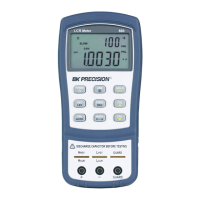
Do you have a question about the BK Precision 880 and is the answer not in the manual?
| Brand | BK Precision |
|---|---|
| Model | 880 |
| Category | Measuring Instruments |
| Language | English |
Defines safety category ratings based on electrical energy available and voltage impulses.
Specifies power requirements and voltage usage for the instrument.
Instructions and warnings for replacing the instrument's batteries.
Procedures for handling damaged instruments and cleaning the device safely.
Warnings about critical applications, live circuits, and fuse replacement.
Guidelines for servicing, unauthorized modifications, and ESD sensitivity.
Recommendations for shipping and handling the instrument.
Lists essential safety guidelines for using the device safely.
Explains various safety symbols used in the manual.
Details on WEEE disposal, compliance, and environmental operating conditions.
Overview of the B&K Precision 880 LCR meter and its capabilities.
Lists all items included with the LCR meter model.
Describes the front panel display elements and button operations.
Detailed explanation of various indicators and segments on the LCD display.
Explains special indicators like errors, calibration, and fuse status.
Describes the different test ports and their connections for measurements.
Step-by-step guide for installing the battery into the instrument.
Instructions for connecting an external AC adapter to power the instrument.
Explains the low battery indicator and its meaning.
How to use and control the LCD backlight for visibility.
Details on battery/external power usage.
Details on the instrument's battery charging process.
How to freeze and hold the measured value on the display.
Using the mode for recording maximum, minimum, and average values.
How to enable, use, and exit static recording modes.
Procedures for performing open and short calibration for accuracy.
How to select primary measurement parameters like L, C, R, Z.
How to select secondary parameters like D, Q, Theta, ESR.
Functionality and usage of the auto LCR detection mode.
How to select and change the test frequency for measurements.
How to select different AC signal test voltage levels.
Options for fast and slow measurement rates.
How to select between parallel and series measurement modes.
Configuring the selectable tolerance percentage ranges.
Step-by-step guide to configure and activate tolerance mode.
How to exit or disable the tolerance mode.
How to access and navigate the instrument's utility menu.
Details on specific menu options like DCR delay, beep sound, auto power-off.
Procedure to reset the instrument to its factory default settings.
How to check the battery voltage status.
Methods for saving or discarding changes when exiting the utility menu.
How to save changes and exit the utility menu.
How to exit the utility menu without saving changes.
Information on USB connection for remote communication.
How the instrument detects and indicates a blown fuse.
Step-by-step guide to measure inductance.
Step-by-step guide for measuring capacitance.
Step-by-step guide for measuring AC resistance.
Step-by-step guide for measuring DCR.
Step-by-step guide for measuring impedance.
Instructions for establishing a connection between the meter and a PC.
Settings for virtual COM port configuration over USB.
Explains remote and auto fetching modes for USB communication.
General information on command types, formats, and SCPI.
Format of messages returned by the instrument.
Explanation of different data types used in communication responses.
Description of common SCPI commands like *IDN?, *LLO, *GTL, *TRG.
Details on FREQuency, VOLTage, and FUNCtion subsystems.
Commands related to tolerance and recording functions.
Command for fetching measurement results.
A table summarizing all supported SCPI commands.
List and explanation of error codes displayed by the instrument.
Recommendations for selecting optimal test frequencies for measurements.
Guidance on test frequency for capacitance and inductance measurements.
Recommendations for parallel/series mode for capacitance and inductance.
Notes on potential inaccuracies in measurements for various components.
Explanation of the guard terminal's purpose and usage.
Specifics on measuring capacitance and dissipation factor.
Specifics on measuring inductance and quality factor.
Details on AC resistance measurement and its considerations.
Table of general technical specifications for the 880 LCR meter.
Detailed accuracy specifications and conditions for measurements.
Tables detailing accuracy for inductance, capacitance, impedance, and DCR.
Formulas for calculating equivalent series and parallel resistance accuracies.
Guidelines for servicing, replacement parts, and cleaning the instrument.
Contact information and procedures for warranty and non-warranty service.
Details of the product's warranty coverage and exclusions.